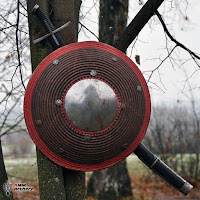 I will now describe various ways of using kalkan shield while it is hanging on a full length loop worn across your shoulder.
I will now describe various ways of using kalkan shield while it is hanging on a full length loop worn across your shoulder.It is important to remember, that this shield was part of warrior more or less complete system of defenses, typically consisting of aketon and helmet of some kind, possibly chainmail, vambraces etc. etc. On our photos we present kalkan placed over a white shirt, but this is only to show clearly how the loop is worn. Description is for a right-handed person.
1. Kalkan hanging freely:
 you put fully extended loop across right shoulder, so the shield is hanging at your left hip. It is convenient to position the loop’s connection point (knot or buckle used to make a loop out of rope or thong) in the bottom, between rings – it will be used later as a kind of tag. You have to hang the shield with the wider of its two side grips facing upwards.
you put fully extended loop across right shoulder, so the shield is hanging at your left hip. It is convenient to position the loop’s connection point (knot or buckle used to make a loop out of rope or thong) in the bottom, between rings – it will be used later as a kind of tag. You have to hang the shield with the wider of its two side grips facing upwards.No matter what evolution we do with our shield, we never remove this loop from the shoulder, so it is not possible to lose the kalkan, even if we drop it by accident or release it to have both hands free – it is extremely important especially to the mounted warrior. The shield hanging on your left hip will not disturb you when using reins, shooting a bow or fencing, and only slightly interfere with drawing a saber from its sheath or a bow from bowcase, which will be partially covered.








